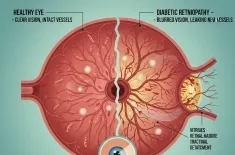Discover the simple food sequencing trick to significantly lower glucose management spikes.
In a world filled with complex diet plans, restrictive eating, and confusing nutritional advice, a truly revolutionary concept is emerging—one that doesn't dictate what you can eat, but rather when and how you eat it. This is the simple, powerful meal order trick that has been scientifically shown to dramatically flatten the post-meal blood sugar curve: the fiber first, protein second, carbs last strategy.
This guide will dive deep into the science behind this simple technique, offering a practical framework for glucose management and demonstrating how this effortless change can transform your metabolic health.
The Science of Food Sequencing: Why Order Matters
For decades, nutritional focus has been almost entirely on the macronutrient composition of a meal—the amount of fat, protein, and carbohydrates. However, groundbreaking research, notably from institutions like Weill Cornell Medical College, has illuminated a crucial, overlooked factor: the order in which these components are consumed.
When you eat, your food travels through the digestive tract, and the rate at which glucose is absorbed into the bloodstream directly impacts your blood sugar level.
- Eating pure carbohydrates first (like a piece of bread or a sugary drink) leads to a rapid breakdown into glucose, a quick rush into the bloodstream, and a sharp, often unhealthy, blood sugar spike.
- Eating fiber and protein first creates a physical and chemical barrier in the stomach and small intestine that significantly slows this process, ensuring a controlled release of glucose.
This strategy—known as food sequencing—is one of the most accessible and immediate lifestyle changes you can make to improve your metabolic response to food.
Step 1: Fiber First – The Essential Digestive Barrier
The journey to lower blood sugar begins with fiber first. This means starting your meal with non-starchy vegetables, a side salad, or a small bowl of fiber-rich soup.
The Fiber Mechanism
Fiber, particularly soluble fiber, is a non-digestible carbohydrate. When it enters your stomach and small intestine, it has two crucial effects:
- Viscosity and Volume: Soluble fiber mixes with water to form a viscous, gel-like matrix. This gel coats the inner lining of the small intestine. This lining is where the enzymes that break down starches (amylase) and the transporters that absorb glucose are located. The gel physically slows down the movement of food, creating a traffic jam.
- Slowing the Enzymes: By coating the intestinal walls, the fiber barrier physically hinders the digestive enzymes from immediately accessing the incoming starches and sugars. This delay is key. It ensures that when the carbohydrates do arrive, their conversion into glucose is stretched out over a longer period, resulting in a gentle, rolling wave of sugar instead of a sharp spike.
Actionable Tip: Aim for 1-2 cups of non-starchy vegetables (e.g., broccoli, spinach, asparagus, cucumber, peppers) as the very first course. Even a small side salad with oil and vinegar dressing is a potent first step.
Step 2: Protein Second – The Satiety and Hormone Powerhouse
After the fibrous starter, the next crucial step is incorporating the protein second component of your meal, often eaten in tandem with or immediately following the fiber.
The Protein and Fat Mechanism
While protein doesn't contain fiber, it plays a powerful role in regulating glucose through two distinct pathways:
- Slowing Gastric Emptying: Protein (and healthy fats, which are often consumed with protein sources) is the most satiating macronutrient. It takes longer to digest than carbohydrates, which keeps the food bolus in the stomach for an extended time. This slower *gastric emptying* rate ensures that the total meal—including the carbohydrates that will follow—is introduced to the small intestine at a much more leisurely pace.
- Hormone Release (GLP-1): Protein stimulates the release of key gut hormones, most notably Glucagon-like peptide-1 (GLP-1). This hormone acts as a natural brake on glucose, performing two essential functions: it stimulates the pancreas to release more insulin, and it further slows down gastric emptying. More insulin, released before the carbohydrates hit the bloodstream, prepares the body for a better metabolic response.
Actionable Tip: Prioritize 3-6 ounces of a high-quality protein source (chicken, fish, legumes, eggs, tofu, beef) immediately after or while eating your fiber.
Step 3: Carbs Last – Maximizing the Shield
Finally, you arrive at the carbs last part of the strategy. By this point, your digestive system is primed:
- The small intestine is coated in a viscous, protective fiber gel.
- The stomach is slowly releasing its contents due to the presence of protein and fat.
- GLP-1 and an early trickle of insulin are already in circulation.
When the starchy or sugary carbohydrates (bread, rice, pasta, potatoes, fruit) finally arrive, the impact is cushioned. Instead of a rapid, unimpeded rush of glucose, the conversion and absorption are met with significant resistance. This mechanism ensures a controlled release of sugar into the bloodstream.
The Glucose Management Benefit
The entire point of food sequencing is to manipulate the rate of glucose entry. By eating carbs last, you reduce the Area Under the Curve (AUC) of your glucose response. A lower AUC means less strain on your pancreas, less opportunity for glucose to spike into an unhealthy range, and a smoother metabolic experience overall. This gentle, flat curve is the ultimate goal for effective glucose management.
Actionable Tip: Simply save your highest-carbohydrate component for the end. If you are having rice and curry, eat the salad and meat/vegetable curry first, and then finish with the rice.
A Visual Guide Demonstrating the Importance of Order
Imagine your small intestine as a highway, and glucose as cars trying to rush onto it.
| Scenario | Meal Order | Highway Analogy | Glucose Response |
|---|---|---|---|
| Traditional Meal | Carbs → Protein → Fiber | Empty highway, no speed limit. | Sharp Spike (High-speed crash of glucose into the bloodstream) |
| Optimized Meal | Fiber first, protein second, carbs last | A thick layer of gel-like sludge (fiber) coats the on-ramp, and traffic cops (GLP-1/protein) enforce a slow, steady merge. | Flat Curve (Smooth, controlled release of glucose over time) |
This visual demonstrates that the order in which you eat your macronutrients matters for controlling blood sugar release. By starting with fiber and protein, you build a physical and hormonal barrier that manages the final carbohydrate entry.
Beyond Blood Sugar: Other Benefits of Food Sequencing
The benefits of the fiber first, protein second, carbs last method extend far beyond immediate glucose management:
- Increased Satiety and Reduced Calorie Intake: Fiber and protein are inherently more satiating. By prioritizing them, you naturally feel fuller sooner, which can lead to eating less of the later-consumed, typically more calorically dense carbohydrates. This aids in weight management efforts.
- Improved Gut Health: Consuming fiber first is a powerful prebiotic action. Fiber feeds beneficial gut bacteria, contributing to a healthier microbiome, which, in turn, is linked to better metabolic health and overall well-being.
- Reduced Insulin Resistance: Consistently lower post-meal spikes mean less demand on the pancreas for massive amounts of insulin. Over time, this gives the body a break and can help improve the cells' responsiveness to insulin, leading to better long-term health and reduced risk of Type 2 Diabetes.
- Sustained Energy Levels: The controlled release of glucose prevents the sharp crash (often called the "sugar crash" or "food coma") that follows a high, quick spike. Instead, you enjoy a steady, sustained flow of energy without the dramatic slump.
Implementing the Trick: Practical Examples
Implementing food sequencing is easy because it requires zero change to your shopping list—only a small adjustment to your plate and fork strategy.
| Meal Type | Traditional Order (High Spike) | Fiber First Order (Low Spike) |
|---|---|---|
| Taco Night | Chips and salsa → Tortilla/Rice → Meat and cheese → Lettuce/Tomato | Lettuce, salsa, beans (fiber) → Meat and cheese (protein/fat) → Small amount of tortilla/rice (carbs last) |
| Pasta Dinner | Garlic bread → Pasta → Sauce and meat → Small side salad | Large side salad (fiber) → Meatballs/Chicken/Tofu (protein) → Pasta (carbs last) |
| Stir-Fry | Rice → Meat and few vegetables | All vegetables (broccoli, peppers, carrots) → Meat/Tofu → Small amount of rice |
| Breakfast | Orange Juice → Cereal/Toast → Eggs | Small side of berries/nuts (fiber) → Eggs (protein) → Toast/Cereal (carbs last) |
Conclusion: The Simplicity of Control
The fiber first, protein second, carbs last strategy is not a fad diet; it is an evidence-based metabolic hack. It offers a simple, zero-cost, and immediately effective way to regain control over your glucose management by leveraging the power of food sequencing.
By consciously choosing the order in which you consume your food, you transform a high-impact carbohydrate rush into a gentle, controlled release of energy. This simple trick is a powerful tool for anyone seeking to lower post-meal spikes, improve energy levels, and take a foundational step toward optimal long-term metabolic health.




































